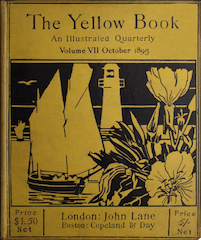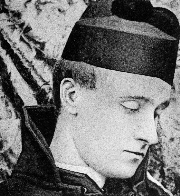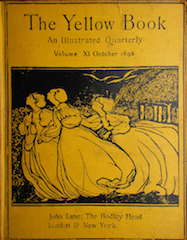The Improbable Juxtaposition of Religion and Morality During the Fin-de-Siècle in Baron Corvo’s “Stories Toto Told Me”
©2019 Rachel Bowman, Ryerson University
INTRODUCTION

Baron Corvo’s fictional literary works entitled “Stories Toto Told Me” are a series of short stories that appear in Volumes 7 (Oct 1895) and 11 (Oct 1896) of The Yellow Book magazine. These stories “About San Pietro and San Paolo” from Volume 7, “About the Heresy of Fra Serafico” and “About One Way in which Christians Love One Another” from Volume 11 fall under the genre of religious legends and folklore. The role of religious folklore in the 1890’s magazine existed to outline the perimeters of morality, while exploiting the actions that oppose those perimeters. An absence of morality appears in the presence of sin, seemingly defined through Roman Catholicism. Although each story varies greatly in plot, the primary characters must all face a challenge in which they choose to go against or preserve their virtue. The challenges include “the experience of hardship, oppression, and invisibility” (Keates 174). Corvo’s work paradoxically captures both moral and social standards and fear. Religious principle is consistently paired with sacrilegious conduct, challenging the reservations held about art during this cultural period. The intricate characters and deliberate plot aim to align with the personal subjectivity of the author, Corvo. Sinful acts such as homosexuality are discussed by artists such as Oscar Wilde, who suffer at great lengths both legally and politically. This negative charge is felt throughout the community of artists, and thus the result is the denial of personal incongruence. This essay will examine the shifting attitudes of the cultural moment of “Stories Toto Told Me” in Volume 7 and 11, reflecting primarily on the ambiguity of morality standards during the fin-de-siècle.
BARON CORVO AS FREDERICK ROLFE

The 1890’s is a period defined by “socialist discourse” (Keates 171), meaning that society desired to have a larger community based regulation in trade while reducing a free-agent economy. The ideals of the market are analogous to the shifting perspective of the culture. Specifically, ideals were becoming more familiar with diversity that was not popularized and the rising academics began questioning the fundamental principles that defined morality in accordance with the Catholic church. The Yellow Book is “in the context of a modern publication attacking the conservative Victorian establishment.” (Marcovitch 83) The fin-de-siècle was notorious for the public rejection of sexual divergence against Oscar Wilde, who was forced to stand trial in 1895. Wilde’s sentencing and the cultural move towards more “manly” pursuits of adventure and imperialism. Though the general feeling towards “sexual controversy” was still present within the Yellow Book, this feeling was more discreet and perilous in Volumes 7 & 11 (Keates 168).
Although Baron’s stories were praised in an effervescent manner at the end of the 19th century, the publication occurred during a transitory cultural movement (Keates 162). Baron Corvo is the pseudonym used by Frederick Rolfe to create his writer’s persona through his story telling, plausibly to avoid any controversy surrounding his own name. The persona was “pensive, ritualistic, celibate” to cover up his emotional vulnerability (Hanson 329-330). Corvo suffered greatly from poverty and the rejection from his “ecclesiastical dream” that his stories became a haven in which he could express the “defenseless and alienated self” (Perosa 112). His stories thus revealed many of his personal afflictions concerning his own identity, including homoeroticism. His rejection within priesthood is ingrained into the development and specificities of the stories. The three stories focused on in this exhibit allowed Corvo to vicariously experience a “dominant position” (Keates 163). Specifically, Corvo identifies with the peasant who tells each story, as this character has an appreciation for religious scripture and mirrors a comparable social position. Corvo desires to reclaim his power through his own fictional writing.
“IMPOSSIBLE JUSTAPOSITION” IN THE DECADENCE MOVEMENT
The Decadent movement at the end of the 19th century characterized by a “fascination with cultural degeneration,” in which “religion, sexuality, art, even language itself, had fallen at last into an inevitable decay” (Hanson 2). The true decay comes from the deterioration of direction of what is considered moralistic and honorable. The rejection of transformative thinking and expression in the fin-de-siècle may have arguably influenced Corvo’s choice to use Roman Catholicism to mask his rebellion. The use of a “cultivated recourse to primitivism” allows Corvo to use religion as a depiction of justice and morality (Perosa 115). Corvo creates a complex cocktail of “improbable juxtapositions” (Hanson 2) throughout his three stories. In every story, there is a religious figure who is supposed to be pure and righteous, yet their divinity is bound to humanistic flaws. It is improbable because the divine is suggested to exist above the average mortal through their impeccable morality, yet the characters attempt to create humanistic affinity through their flaws. San Pietro steals and does not obey, Pappagallo participates in heresy due to his own jealousy, and Toto participates in superstition regarding the burial place of the baby. Corvo’s appeal to sanctity through his stories is an attempt to deny and avoid the unconventional aspects on his own sexuality and socioeconomic status. The “revealing striking experimental aspects” of classic Decadent writing sets the stage for the trends in 20th century fiction (Perosa 112).
RELIGIOUS FOLKLORE AND LEGENDS AS A LITERARY GENRE
Religious folklore and legends is a genre that collects tales from the “rural working class, elite educated men,” demonstrating that the genre is easily transferable through word-of-mouth (Harris 10). The mentioned stories in The Yellow Book are a subtle concoction of “myth, saints’ lives, and Italian folklore” (Keates 162). The tone of the folktale titled “About San Pietro and San Paolo” is traditional folklore in the way that it is presented as a conversation (Harris 4). The dialogue exchanged within the story reflects the conversational tone of the narrator, Nicola, to his listener, Serafico. The story discusses the quarrel between San Pietro and San Paolo while building their churches on Earth. San Pietro “urged on by vanity … had taken the
property of San Paolo for his own church on the Monte Vaticano” and Padre Eterno warns him to not disobey him (Corvo 213). The emphasis behind the moral of story is to not act immorally by stealing or disobeying God, thus reflecting the “collective experiences and values of the group to whose traditions it belongs” (Harris 4). There is a collective value in the rules and regulations among mortals and the saint. The act of disobeying God’s word through scripture in the Victorian age was a considered a sin, hence the use of “legend elements to symbolize their fears” (Harris 5). The most important aspect of the story is the impending threat of disobedience.

Similarly, in the tale “About the Heresy of Fra Serafico”, Nicola defends the religion he practices fiercely, while also fearing he had invented and proclaimed 16 new and unheard of heresies in his sermon. Toto comforts his brother Nicola by relaying a story of Serafico, who was ordered by Father Guardian to give a sermon before the convent after being accused of similar wrongdoings. The character of Fra Serafico “went about his duties with diligence and humility, feeling so shy, because the things around him were so strange.” (Corvo, 146). Corvo relates to Fra Serafico because he too struggles to go about his religious beliefs in a stereotypical manner. The “pervasive and perennial threats” (Harris 5) of the story influence the audience to refrain from behaving through acts of egomania, such as jealousy or contempt, a pressure felt through Corvo’s generation. The point of reproducing stories that teach a lesson through religion is to establish a hierarchy amongst mortal and divine characters. Mortals, such as the reader, are emotionally engaged using a humanistic quality of envy in the story, and are provoked to reject it.
The third and final story, “About One Way in which Christians Love One Another” from Volume 11, attends to the human’s ability to be a devotee. The mother struggles to help a mysterious woman to deliver a baby, which results in complications and the eventual death of the baby. This tale suggests less that Toto’s mother, has somehow broken her religious faith in practice, but rather accentuates the common tradition of superstition. According to the story, “the new baby had come and died a Christian, there was nothing else for them to do but to bury it in their churchyard, and that secretly, to defend la Signora Pucci from shame.” (Corvo 160-161) Though the practices of religion are used successfully, there is still a motive to protect themselves from the scandal of the event. They go as far as to not tell Signora Pucci’s partner of the birth at all and chose to bury the child in secrecy. Toto fears that the burial place of the child may taint the fortune of the priest’s descendants for generations to come (Corvo 162). The perception that one’s own transgression may affect the personal affairs of another is exactly the influence religious folktale. The collectivity of the human experience means that we are all responsible for holding each other to a sacred theological standard. The function of legends therefore is to embody the rectitude of the audience, eventually using this lingual approach to influence a culture intrinsically.
CONCLUSION
In conclusion, the Decadence movement allowed the proper environment for the experimental writings of Corvo. His “imaginative power” is invented to give an authoritative voice to the “sequence of brief episodes, descriptive moments, idyllic scenes, picturesque details and decorative touches” of all three stories (Perosa 120). He used his religious beliefs to mask the imperfection of his personal life through storytelling, thus challenging the cultural standards of morality. This observation adds to the scholarly conversation about religious folklore and legend as it exemplifies the shifting attitudes towards the fin-de-siècle. Analyzing Corvo’s writing through the lens of Hanson’s “improbable juxtaposition” helps the reader unify the pressure within society to conform to ideals with a natural tendency to stray away from those same ideals. The fin-de-siècle was defined by the upheaval of tradition, thus aligning with both the personal and literary life of Corvo. The significance of this analysis is to understand the historic prevalence of a deep chasm within an evolving society. The implication of the conclusion is that artists were using the ambiguity of their writing to express their desires and receive cultural feedback through rebellious innuendo. Baron Corvo’s “Stories Toto Told Me” celebrates the function of hierarchy and punishment through the motives and choices of characters (Keates 175). The conscious use of traditional folklore and legend elements in the three stories allows for both the implicit and explicit messages to penetrate the normative functionalist model of society.
Works Cited
Corvo, Baron [Frederick William Rolfe]. “Stories Toto Told Me” The Yellow Book 7 (Oct. 1895): 209-24. The Yellow Nineties Online. Ed. Dennis Denisoff and Lorraine Janzen Kooistra. Ryerson University, 2012. Web. [Date of access]. http://www.1890s.ca/HTML.aspx?s=YBV7_corvo_stories.html
Corvo, Baron. “Stories Toto Told Me.” The Yellow Book 11 (Oct 1896): 143-162. The Yellow Nineties Online. Ed. Dennis Denisoff and Lorraine Janzen Kooistra. Ryerson University. Web. [Date of access]. http://www.1890s.ca/HTML.aspx?s=YBV11_corvo_stories.html
Ford, Keates, et al. “Camp Aesthetics and Inequality: Baron Corvo’s Toto Stories” Economies of Desire at the Victorian Fin de Siècle, Routledge, 2015, pp. 162-179. Taylor & Francis Group https://www-taylorfrancis-com.ezproxy.lib.ryerson.ca/books/e/9781317576594/chapters/10.4324/9781315739373-18
Hanson, Ellis. Decadence and Catholicism. Harvard University Press, 1997.
Harris, Jason Marc. “An Introduction to Folklore and the Fantastic in Nineteenth Century British Literature” Folklore and the Fantastic in Nineteenth-Century British Fiction, Ashgate Publishing Limited, 2008, pp. 1-35.
Marcovitch, Heather. The Yellow Book: Reshaping the Fin de Siècle. Literature Compass, vol. 13 issue 2, John Wiley & Sons Ltd, February 2016, pp. 79-87. Wiley Online Library, https://onlinelibrary-wiley-com.ezproxy.lib.ryerson.ca/doi/full/10.1111/lic3.12292
Perosa, Sergio. “The Fiction of Frederick Rolfe, “Baron Corvo””. The View of the English and American Novel, vol. 4, University of Manitoba Press, 1971, pp. 111-124. ProQuest, https://search-proquest-com.ezproxy.lib.ryerson.ca/docview/1300044324/fulltextPDF/B391C644E54C4E7DPQ/1?accountid=13631
Images in this online exhibit are either in the public domain or being used under fair dealing for the purpose of research and are provided solely for the purposes of research, private study, or education.
